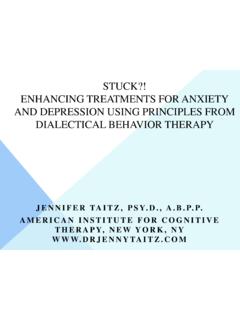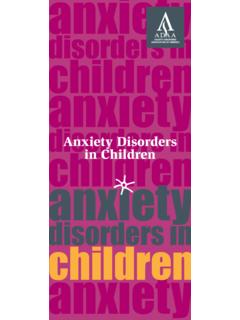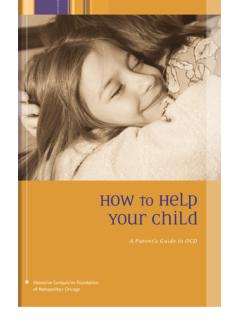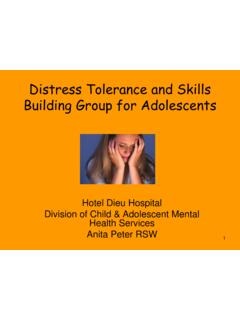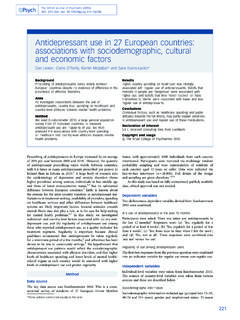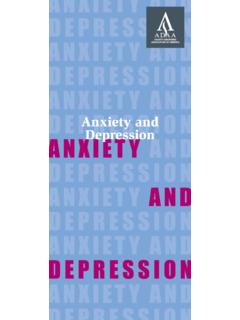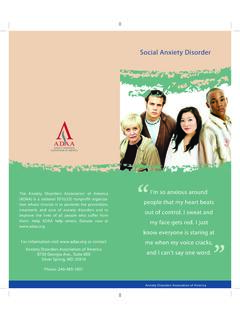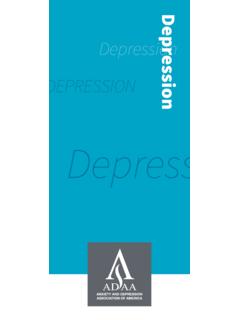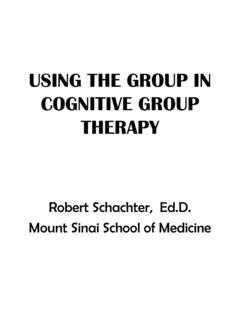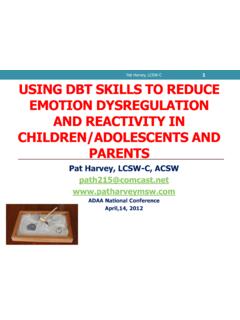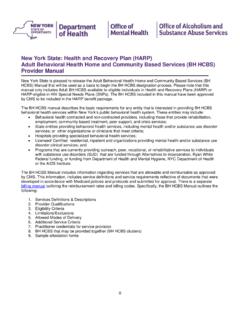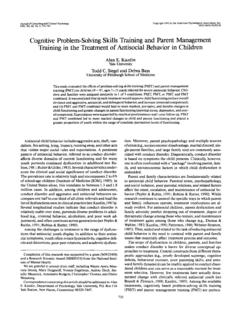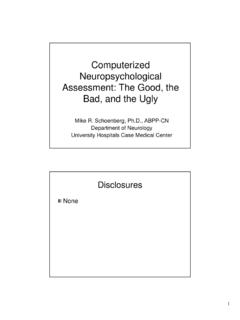Transcription of CBT For Suicidal, Depressed Adolescents
1 cbt for suicidal , Depressed Adolescents Anthony Spirito, PhD, ABPP. Alpert Medical School of Brown University DISCLOSURES. None Acknowledgements Sponsors Major Collaborators on American Foundation for Suicide Prevention Treatment Studies Van Amerigen Foundation Christianne Esposito- Harvard Pilgrim Research Smythers, Foundation Deidre Donaldson, National Institute on Alcohol Abuse and Alcoholism (AA14191; AA020705) Jeffrey Hunt, National Institute of Mental Health (57349; 01783; Jennifer Wolff, 66014;082211;083092;086. 606;099703). I Conceptual Model II CBT for adolescent Depression- Effects on Suicidality III Managing Suicidality in Therapy IV Working with Parents during suicidal Crises V CBT Techniques for Suicidality VI Special Circumstances . Alcohol Abuse and Suicidality CBT MODEL OF adolescent .
2 suicidal BEHAVIOR. Trigger cognitive Affect SUICIDE suicidal Distortion & Dysregulati ATTEMPT Thinking Deficiency on Maladaptive Behaviors Spirito, Esposito-Smythers, et al., 2012. Predisposing Vulnerabilities This model posits that there is a predisposing vulnerability among youth who attempt suicide including: Significant genetic predisposition toward psychopathology (Brent et al, 2008). Exposure to significant negative life events, such as a history of abuse or neglect (King & Merchant,2008). Predisposing Vulnerabilities Adverse parenting resulting from parental psychopathology (Melhem et al, 2007). Peer victimization and bullying (Kim & Leventhal,2008). Vulnerabilities make it more likely that they will experience maladaptive cognitive , behavioral , and emotional responses to acute stressors STRESSORS.
3 Stress, typically from an interpersonal conflict, may initially trigger a depressive episode and/or suicidal crisis in predisposed Adolescents . Higher catastrophizing, selective abstraction, overgeneralization, personalization and total cognitive errors have been found in suicidal compared to non- suicidal adolescent inpatients with a mood disorder (Brent et al, 1990). PROBLEM-SOLVING DEFICITS. , Predisposed youth may also experience difficulties generating and/or selecting solutions to a stressor. suicidal Adolescents report greater difficulty generating and implementing effective alternative solutions to problems compared to non- suicidal Adolescents (Adams & Adams, 1996). suicidal youth are also more likely to view problems as irresolvable (Orbach et al, 1999).
4 AFFECT DYSREGULATION. This difficulty in cognitive processing and problem-solving, which is also characteristic of Depressed Adolescents , can result in negative affect including anger and a worsening of the current mood state (Daniel et al, 2009). suicidal Adolescents report greater difficulty regulating their internal states and using affect regulation skills compared to non- symptomatic Adolescents (Fritsch et al, 2000). MALADAPTIVE COPING. Self-medication may also be used as an means to reduce negative affect via Alcohol or drugs (Esposito-Smythers & Spirito, 2004). Non- suicidal self-injury - cutting or burning oneself- has also been described as an emotional release (Guertin et al, 2000). The maladaptive behavior chosen may have been modeled by parents, peers, or other important figures REPETITIVE CYCLE.
5 Adolescents may cycle through this cognitive , affective, and behavioral process numerous times, with each cycle leading to greater Depressed mood. This cycle may take place over a few days, weeks, or even months. Either way, the end result of this cycle, if not interrupted, is intolerable affect and the perception that the situation is hopeless. Adolescents may then begin to experience passive suicidal thoughts, such as I would be better off dead . which over time may become active suicidal thoughts, and a suicide attempt, with or without prior planning, may result. SUICIDE ATTEMPTS. suicidal behavior can be the outcome of this : Distorted cognitive processing Lack of perceived adaptive solutions Heightened affective arousal related to the stressor SENSITIZATION.
6 INCREASES RISK. Once suicidal behavior occurs, it may sensitize Adolescents to future suicide- related thoughts and behavior (Joiner, 2005). suicidal behavior makes the suicidal cognitive schema more easily accessible in future stressful situations (Beck et al, 1996). SENSITIZATION. Joiner (2005) suggests that suicide attempts habituate individuals to the experience of engaging in dangerous self-injurious behavior. When combined with interpersonally-related cognitive distortions, this habituation increases the possibility of future suicidal behavior Once the taboo against suicide has been broken, it becomes easier to view suicide as a viable solution to life's problems II - CBT for adolescent Depression Does it affect Suicidality? Do we need to specifically treat suicidality or is treatment of depression enough?
7 Large studies conducted in the last decade have shown that CBT for depression in Adolescents does result in reducing suicidality. TADS AND TORDIA. TADS Slight protective effect At 12 weeks, reductions in SI were greater for youth randomized to combination therapy than fluoxetine therapy, CBT only, or placebo, though SI was lower than baseline in all conditions. At 36 weeks, suicidal events were more common in patients treated with fluoxetine alone ( ), compared to for combination and for CBT alone (March et al, 2004; 2007). TORDIA. of participants reported clinically significant SI and reported a prior suicide attempt. SI decreased from baseline to post- treatment for participants across all conditions. 5% of participants attempted suicide and 20% experienced a self-harm related event (SI, suicide attempt, self-injurious behavior) during treatment, with no differences across conditions.
8 (Brent et al, 2008). RCTs with adolescent Suicide Attempters Day Treatment (Rudd et al, 1994). Family (Harrington et al, 1998). MST (Huey et al, 2004). Individual CBT ( Donaldson et al, 2005). Group (Wood et al, 2001; Hazell et al, 2009; Green et al, 2011). TASA (Brent et al,2009). Intensive Individual CBT and Parent Training (Esposito-Smythers, Spirito, et al, 2011). RCTs with adolescent Suicidality Diamond et al (2010)- SI;attachment based family therapy Rossouw et al (2011);SIB mentalization therapy Tang et al (2009) SI IPT-A. Ougrin et al (2011,2013) SIB - Therapeutic Assessment Asarnow et al (2011) SI/SA ED. intervention improved adherence Pineda & Dadds (2013) SI/SA . Resourceful adolescent Parent Program . Postive effect on composite score of suicidality Issue: Why so few studies?
9 High risk period is 1-4 weeks post discharge Difficult-to-treat high risk sample Affect arousal high Impulse control low Emotional regulation poor Comorbidity common Families often dysfunctional Treatments of Choice? Most likely CBT and DBT plus family/parent training will be primary psychotherapies tested in future trials Why? Directive which is important when addressing suicidal behavior They have flexibility to address varying presentation and risk factors For example, most but not all Adolescents who attempt suicide are Depressed so need flexibility to address other factors than just depression Treatment of Choice? Brent et al. (1997) study on Depressed Adolescents indicated that nondirective, CBT, and family therapy had similar effects on depression.
10 Re-analyses indicated that suicidal Depressed Adolescents faired less well in terms of depressive outcomes in the supportive, nondirective condition than in the CBT condition (Barbe et al., 2004). III Managing Suicidality in the Course of Treatment Passive death wish suicidal thoughts without plan or intent suicidal thoughts with plan or intent suicidal threat Interrupted attempt (by self). Aborted attempt (by another). Suicide attempt with explicit or inferred intent to die CASES. DOES ANYONE HAVE CASES. THEY WOULD LIKE TO DISCUSS. AS WE GO THROUGH THESE. MANAGEMENT TECHNIQUES? ASSESSMENT OF SI - Intensity, Frequency, Duration Proportion of day with suicidal thoughts. In a given hour, how much do you think about suicide? How well can you push away suicidal thoughts and think about something else (scale 1-10).
